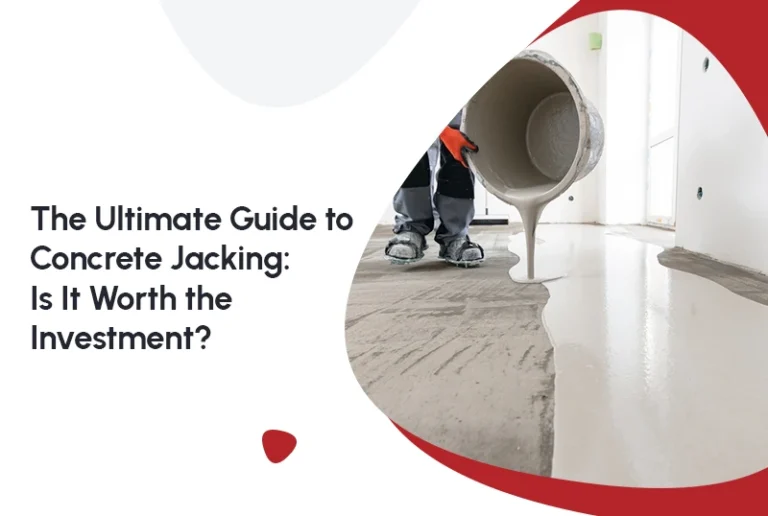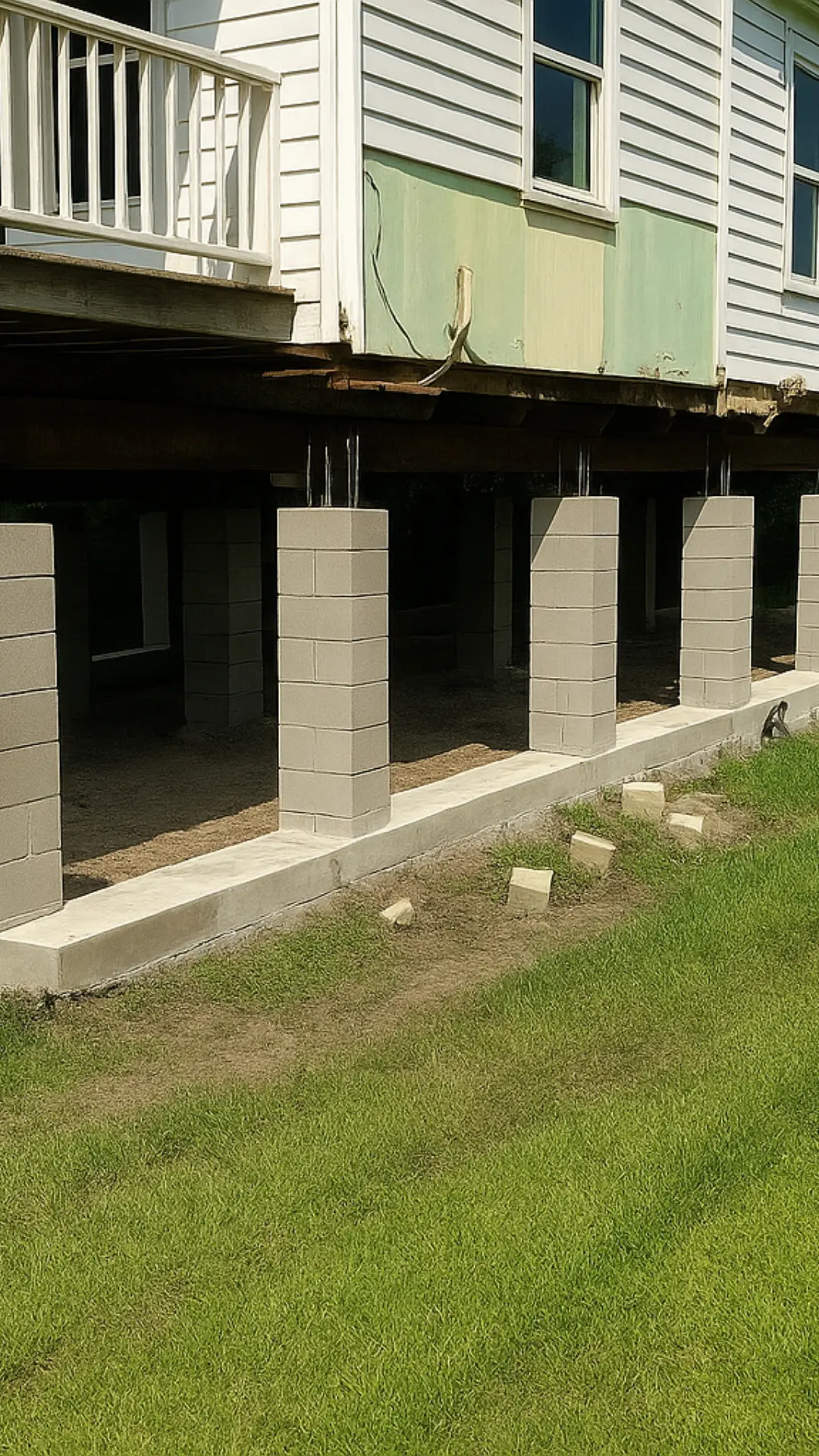When it comes to addressing foundation repair issues in your home, few decisions are more critical than whether to repair or replace your foundation. Foundation problems can compromise your home’s safety, stability, and long-term value. Homeowners often face a pressing question: should they invest in repairing the current foundation or opt for a complete replacement?
Both routes involve varying levels of cost to fix foundation, time to fix foundation, and disruption of fixing foundation, and the right choice depends on multiple factors. In this guide, we’ll examine the key elements that influence the cost to fix a foundation, when replacement becomes necessary, and how to make the most informed and affordable decision.
What Does Foundation Repair Involve?
Foundation repair is typically a more cost-effective and less invasive solution than replacement, provided the structural issues are not too severe. Repairs are designed to address specific problems, restoring the foundation’s strength and stability without a full reconstruction.
Common Foundation Repair Methods:
- Crack Filling: Minor cracks caused by settling or temperature changes can be injected with epoxy or polyurethane to prevent water infiltration and further deterioration. These methods are affordable and quick.
- Pier & Beam Foundation Repair: In homes with pier and beam foundations, repairs may include re-shimming beams, replacing deteriorated wooden piers, or resetting displaced concrete piers.
- Concrete Leveling (Slabjacking or Mudjacking): A technique used to lift sunken concrete slabs by pumping a grout mixture underneath. Alternatively, polyurethane foam injection can also be used for faster results with less disruption.
- Helical or Steel Push Piers: For deeper structural issues, piers can be installed under the foundation to transfer the structural load to stable soil or bedrock.
- Drainage Correction: Poor drainage is a common cause of foundation issues. Installing French drains, gutters, and regrading soil can prevent future damage.
Average Repair Cost:
The cost to fix foundation issues depends on the severity of the problem and the repair method used. Typically, repairs can range from $1,000 to $10,000 or more for more severe issues.
When Is Foundation Replacement Necessary?
Foundation replacement is generally considered a last resort. It involves demolishing and rebuilding part or all of the existing foundation. Although significantly more expensive and disruptive, replacement may be necessary in cases of severe structural failure.
Situations That May Require Full Replacement:
- Widespread structural cracks or instability
- Repeated water infiltration and mold issues
- Severely deteriorated piers or beams in pier & beam foundations
- Irreparable soil movement or expansive clay conditions
- Outdated or unsafe foundation materials in older homes
Types of Foundation Replacement:
- Pier & Beam Foundation Replacement: Pier & beam foundation repair may involve lifting the home off its foundation to replace the wood beams or piers entirely. In some cases, concrete piers or steel screw piles are installed for longer-lasting stability.
- Concrete Slab Replacement: The old slab is removed and a new one poured, often with better reinforcements and improved grading to prevent future issues.
Replacement Cost Range:
Cost to fix foundation can be anywhere from $15,000 to $50,000+, depending on:
- Home size
- Type of foundation
- Soil conditions
- Labor and material costs in your region
Comparing the Cost to fix Foundations: Repair vs. Replacement
Now that we’ve outlined the cost to fix foundation with repair and replacement, let’s break down the key factors to consider when deciding which option is more affordable.
1. Extent of the Damage
If your foundation has only minor cracks or settling, a targeted repair is usually sufficient and more economical. However, severe damage may be too complex or risky to patch. Multiple large cracks, bowing walls, and floor separation may indicate deeper structural failure, warranting replacement.
2. Foundation Type
- Pier & Beam: Often more repairable due to the access under the structure. Beams can be replaced without touching the entire structure.
- Concrete Slab: Difficult to access for repairs; slab issues often require lifting or replacement if leveling fails.
3. Long-Term Value & Durability
- A well-executed repair can extend a foundation’s life by decades.
- A replacement is a long-term investment, often adding value to the home and appealing to buyers wary of structural problems.
- Although repairs might have a lower up-front price tag, repeated repairs could make the cost to fix foundation higher in the long run. Full replacement, though more costly initially, may offer decades of stability.
4. Time & Disruption
- Repairs usually take 2–7 days depending on complexity.
- Replacement can take 2–4 weeks and may require homeowners to vacate the property temporarily.
5. Cost to fi foundation Comparison Summary:
| Factor | Repair | Replacement |
|---|---|---|
| Typical Cost | $1,000–$10,000 | $15,000–$50,000+ |
| Timeline | 2–7 Days | 2–4 Weeks |
| Disruption | Minimal | Significant |
| Longevity | 10–30 Years | 50+ Years |
Additional Costs to Consider
- Permits and Inspections: Local building codes may require permits for foundation work, adding $200–$1,000+.
- Engineering Reports: Structural engineers may need to assess the foundation before major work begins. Expect to pay $300–$800.
- Landscaping Repairs: Replacing or excavating a foundation may destroy sidewalks, gardens, or driveways.
- Waterproofing: For long-term durability, add waterproofing membranes or drainage systems during replacement or repair.
What Factors Affect the Cost to Fix Foundation?
Several factors can influence the cost to fix foundation issues, including:
- Size and Layout of the Home: Larger or multi-story homes require more labor and materials.
- Soil Type: Clay-rich soils expand and contract more, leading to instability and higher repair costs.
- Climate and Water Table: Areas with heavy rainfall, snow, or high water tables increase risk and complexity.
- Location: Regional labor rates and material availability can affect the cost to fix foundation in urban vs. rural areas.
- Home Age: Older homes may use outdated materials or construction methods, requiring custom solutions.
- Accessibility: Foundations surrounded by trees, fences, or neighboring homes may be harder to excavate. Limited access around the foundation can increase labor time and effort, thereby affecting the cost to fix foundation.
How to Decide: Repair or Replace?
Ask yourself these questions:
- Is the damage localized or widespread?
- Is there evidence of repeated repairs that have failed?
- What’s the projected lifespan of a repair vs. replacement?
- How long do you plan to stay in the home?
A qualified structural engineer can provide an unbiased recommendation based on inspection and soil testing. For severe cases, they may recommend replacement to ensure long-term safety and property value.
Conclusion
Both foundation repair and replacement serve important roles depending on the condition and type of damage present. Minor cracks, uneven settling, or water issues can often be resolved with timely, cost-effective repairs. On the other hand, extensive structural failures, long-term soil movement, or outdated foundation systems may necessitate a complete rebuild. While the cost to fix foundation (repair) is often more affordable and suitable for minor issues, concrete slab foundation repair may be necessary if the damage is extensive and affects the stability of your home.
The key is to act early. Delaying repairs can lead to worsening damage and skyrocketing costs. Consult with a foundation expert and a structural engineer to weigh the cost to fix your foundation versus replacing it. Your home’s safety and value depend on a stable foundation—choosing the right solution is an investment in peace of mind.
FAQs
1. Is it expensive to fix a cracked foundation?
Cost to fix foundation can anywhere from $500 to $10,000, depending on the extent of the damage. Hairline cracks caused by minor settling are usually inexpensive to repair with epoxy or polyurethane injections. However, if the crack indicates structural problems or soil movement, the repair may involve piering or underpinning, which significantly raises costs. Catching cracks early and ensuring proper drainage can help avoid costly repairs.
2. How serious are cracks in a foundation?
Not all foundation cracks are serious, but they should never be ignored. Vertical or hairline cracks are common and typically caused by minor settling, while horizontal or stair-step cracks often signal more serious structural issues. Cracks wider than ¼ inch or those that continue to grow are signs of soil pressure, moisture intrusion, or shifting foundations. A professional inspection can determine if repairs are urgent.
3. What type of foundation repair is most expensive?
The most expensive cost to fi foundation is underpinning with steel or helical piers, which can cost between $10,000 and $30,000. This process involves installing deep supports beneath the foundation to stabilize or lift it back into position. Though costly, underpinning is often the only long-term solution for homes suffering from severe settling, soil erosion, or structural instability.
4. What does a concerning foundation crack look like?
A concerning foundation crack is usually horizontal, wide, or stair-step shaped—especially when found in brick or concrete block walls. These cracks often suggest soil pressure or water buildup pushing against the foundation. Other warning signs include uneven floors, jammed doors, and widening gaps around windows. If you notice multiple symptoms together, it’s best to have the foundation professionally evaluated.
5. How much does it cost to lay a foundation?
The cost to lay a new foundation typically ranges between $5,000 and $25,000, depending on size, design, and soil conditions. Concrete slab foundations are the most affordable option, while crawl space and basement foundations cost more due to excavation and materials. Proper site preparation, drainage installation, and reinforcement are essential to ensure long-term durability and prevent future settling or cracking.
6. How much does it cost to adjust a foundation?
Adjusting or leveling a foundation usually costs between $3,000 and $8,000, depending on the method used. For mild settling, contractors may use mudjacking or slabjacking, which involves pumping a grout mixture beneath the foundation to lift it. Severe settling often requires piering, which stabilizes the home using steel or concrete piers. The cost varies with soil conditions, home size, and depth of the foundation.
7. Can a sagging foundation be fixed?
Yes, a sagging foundation can be repaired using several techniques. Piering or underpinning lifts and stabilizes the foundation, while slabjacking raises concrete slabs by injecting material beneath them. In some cases, wall anchors or braces are installed to prevent further movement. Early intervention is crucial—repairing a sagging foundation promptly prevents secondary damage like cracked walls or uneven floors.
8. What is the cheapest way to repair a foundation?
The cheapest cost to fix foundation is to address small cracks early before they worsen. DIY epoxy or polyurethane kits are affordable for hairline cracks. For minor unevenness, mudjacking offers a cost-effective fix. Maintaining proper drainage, keeping soil moisture consistent, and sealing exterior surfaces can also prevent further damage—saving thousands on future repairs.
9. How do you repair a damaged foundation?
Repairing a damaged foundation depends on the problem’s severity. For minor cracks, sealants and epoxy injections work well. For shifting or sinking foundations, pier systems—such as helical or steel piers—are installed to stabilize the structure. If water damage is the cause, waterproofing and improved drainage are essential. Professional assessment ensures the right method is used for lasting results.
10. Is it cheaper to replace or repair concrete?
It’s usually cheaper to repair concrete than replace it. Small cracks and surface issues can be sealed or resurfaced for a fraction of the cost to fix foundation. Full replacement is only necessary if the foundation is extensively damaged, crumbling, or unsafe. Professional repair methods like resurfacing, epoxy filling, or piering provide long-term solutions while preserving most of the existing structure.







